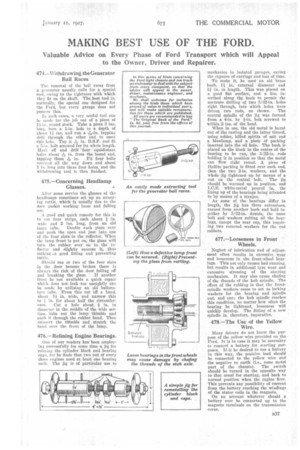MAKING BEST USE OF THE FORD.
Page 57

If you've noticed an error in this article please click here to report it so we can fix it.
Valuable Advice on Every Phase of Ford Transport which will Appeal to the Owner, Driver and Repairer.
474.–Withdrawing the Generator Ball Races
The removal of the ball races from a g+ nerator usually calls for a special. tool, owing to the tightness with which they fit on the shaft. The best tool is, naturally, the special one designed for the Ford, but every garage does not possess this.
In such cases, a very useful tool can be made for the. job out of a piece of 14--in, round stock. Take a piece 3 ins. long, bore a 1-in, hole to a depth of about if ins, and run a k-in. tapping drill through the other end to meet this hole. Tap it e'ek-in. B.S.F. and fit a 3-in. bolt screwed for its whole length. Marl; off and drill 'four equidistant holes about A-, in. from the bored end, tapping these in. Fit four bolts screwed all the way down and about 1 in. long into these four holes, and the withdrawing tool is then finished.
475.—Concerning Headlamp Glasses.
After some service the glasses of the headlamps sometimes set up an annoying rattle, which is usually due to the door gasket working loose and falling out.
A good and quick remedy for this is
to cut four strips, each about inwide and 2 ins. tong, from an old inner tube. Double each piece over and push the open end just into one of the four slots in the reflector. When the lamp front is put on, the glass vill turn the rubber over on to the reflector and slightly squeeze it, thus making .ft good fitting and preventing rattle.
Should one or two of the four slots in the door become broken there is always the risk of the door falling off and breaking the glass. If another front be not available a quick repair which does not looktoo unsightly can be made by utilizing an old balloontyre tube. From this cut Off a band, about 714 in. wide, and narrow this to -1 in. for about half the circumfer
ence. Cut a bole about in, in diameter in the middle of the wide section. take out the lamp thimble and push it through the rubber band. Then reinsert the thimble and stretch the hand over the front of the lamp.
476.—Relining Engine Bearings.
One of our readers has been employing successfully for some time a jig for relining the cylinder block and bearing caps, for he finds that two out of every three engines need at least one bearing each. The jig is of particular use to
mechanics in isolated garages, saving the expense of carriage and loss of time. To make it, lie used an old brass
bush, in. external diameter and If in. in length. This was placed on a good fiat surface, and a line inscribed along the bush to permit the accurate drilling of two 3/32-in, hales right through, into which holes were driven two rods, as shown. The central spindle of the jig was formed from a 4-in, by bolt screwed to within 2 ins. of the head.
When in use, the old metal is burnt out of the casting and the latter tinned, using solder, killed spirits of salt and a blowlamp, and a piece of packing inserted into the oil hole. The bush is placed on the block in the centre of the bearing to be run, the 3/32-in. rods holding it in position so that the metal can flow right round. A piece of Halite packing is fitted over each end, then the two 2-in, washers, and the whale:jig tightened up by means of a nut on the central bolt. The jig should be warmed up in position, and I.C.E. white-metal poured in, the lining up of the bearings being attended to by means of a scraper. .
As some of the bearings differ in length, the jig has three extensions, turned from another bush and held together by 3/32-in, dowels, the same bolt and washers suiting all the bearings, except the near cap, this requiring two recessed washers for the end rabbets.
477.—Looseness in Front Wheels.
Neglect of lubrication and of adjustment often results in excessive wear and looseness in the front-wheel bearings. This not only causes bad running, but results in additional tyre wear and excessive stressing of the steering mechanism. It may also cause chafing of the threads of the hub spindle. The effect of the rubbing is that the frontspindle washers cease to act as locking washers for the bearing and spindle nut, and once the hub spindle reaches this condition, no matter how often the bearing be tightened, looseness will quickly develop. The fitting of a new spindle is, therefore, imperative.
478.—The Use of the Yellow Wire. • Many drivers do not know the purpose of the yellow wire provided on the Ford. It is in case it may be necessary to connect a battery for starting purposes. if it be desired to use a battery in this way, the positive lead should be connected to the yellow wire cud the negative to earth (i.e., some metal part of the chassis). The ,S8VitCh should be turned in the opposite way to that usual for starting, and back to normal position when the engine fires. This prevents any possibility of current from the battery reaching the windings of the stator coils in the magneto.
On no account whatever should a battery ever be connected up to the magneto terminals on the transmission cover,




































































































